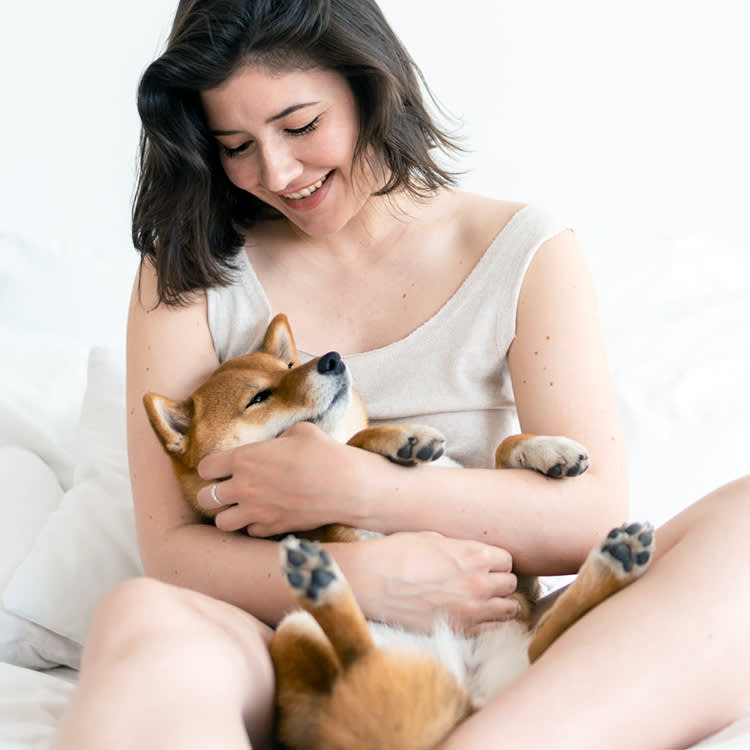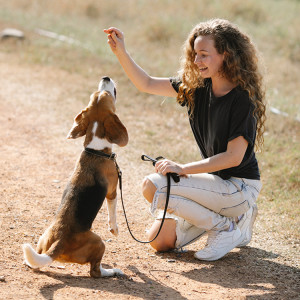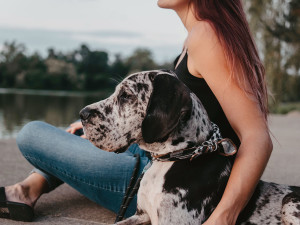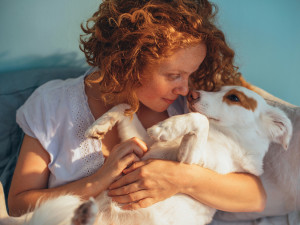Dogs Need Consent, Too—Here’s How to Let Them Have a Say
You aren’t the only one with boundaries.

Share Article
During these unprecedented times (when is the last time we’ve had precedented times?), I’ve been rewatching old TV shows. It’s too risky to introduce new things to a nervous system that’s rocked daily by the news cycle, so I’ve pretty much kept a constant rotation of Gilmore Girls, Friends, and New Girl in the past eight months. New Girl, a reliable supply of 2010s nostalgia, has an episode that tells the story of Jess’s (played by Zooey Deschanel) senior prom night. Her date is the co-president of her school’s Gender Equality Society who takes the concept of enthusiastic consent a little too far, asking for permission so often it sucks the romance right out of the room.
Jess’s prom story proves the point that you really can take any concept — however healthy and wonderfully progressive — too far. But in 2025, we can (or should) all agree that consent is a very good thing, and it shouldn’t just come into play with romantic partners. Not to sound too after-school special-y, but consent is something we should practice with everyone in our lives, including our dogs.
We actually need to ask our dogs for consent.
And maybe that’s obvious to you. But it’s not something that I ever really thought about. Growing up in an emotionally volatile household — constant slamming doors, yelling, screaming, name-calling — I looked for the closest safe space to hide. Often, that was the neck of my childhood dog, Cinnamon, whose fur was warm and soft and a great place to conceal tears from parental eyes. Did Cinnamon love that I would use her body as a glorified squeegee for all my pre-teen angst? Probably not. But I never thought about it.
So, when I grew up and got my Cattle Dog-mix, Georgie, I treated her the same way as Cinnamon — an instant cuddle machine. Georgie, however, often grumbles and growls the second my hands or face make contact with her fur. For nearly eight years, I have loved her unconditionally, and she has loved me with deep reservation. It legitimately hurts my feelings, and at one point, I thought I would never get over it.

But when I saw that there’s an entire section on TikTokopens in new tab for consent-based dog training, I decided to try some of the techniques with my reluctant little love bug. Instead of just going in for a hardcore hug, no notice, I try a cue word with her now. I ask her a word she already knew from years of pleading for affection: “Cuddles?” Now, I just say it less desperately and without my hands prematurely reaching out toward her. And then I watch her body language. If she exposes her stomach to me, that means she is open to touch; she’s big on the belly rubs.
Then, we go from there. If she continues to be down for pets, looking at me with a soft gaze and a relaxed face, I know she may be open to me getting a little closer and snuggling in (while keeping at least one hand rubbing that belly, of course). If she starts to move her body away from me and averts eye contact, I know it’s time to stop. Sometimes, though, I’ll stop, and she’ll scream-bark at me to pet her again. It’s helpful that she’s not subtle.
Sometimes, when I say the cue word, she keeps her body tight in a curled little ball or turns away from me. That means, “This is not a good time.” She probably also adds in some profanity, but I can’t be sure. I was honestly surprised that Georgie — who, let’s face it, savors her position as my overlord — actually responded to the consent training technique.
There are many ways to ask our pups for permission.
Mikkel Beckeropens in new tab, the lead animal trainer for Fear Freeopens in new tab, tells me that she’s actually not shocked my bossy little monster responded so well to being asked for consent. She says that my “cuddles” cue with Georgie is actually something she calls “a communication or predictor cue.” When I use that word with Georgie, I am telling her what I would like to happen next and essentially making sure that’s cool with her. Becker’s version of this cue is to ask, “Pet?”
“It’s really about letting it be a mutual interaction,” she tells me, adding that it’s really easy for humans to only consider their own needs and not their pets’. She continues: “It’s hard, too, even as a dog trainer. I love Pugs and Mastiffs for instance; those are dogs I’m drawn to, and there’s like the instant response of ‘I just want to love on you.’ I need to remind myself, like, ‘OK, I need to let the dog close in that approach.’ ... We get so close and accustomed to our dogs, and we have our own idea of what that relationship should look like.”
She tells me that, by instituting a system of respect with Georgie, I am telling her I am invested in our relationship. I am saying, “Hey, things don’t always have to be about me. I care what you think and want, too.” And she stores that information away in her smart little doggie brain.
“By doing that, you really are building that process and building a deeper bond and helping to reduce a dog’s need to move away,” Becker says.
What happens when you actually can’t accept their dissent?
OK, so I totally get that I should back off when Georgie doesn’t want a snuggle session. But what about when she needs her nails trimmed at the groomer or to get a yearly vaccination at the vet? She can tell me no, but it kind of has to happen for the sake of her health. I ask Becker how Fear-Free certified professionals might make mandatory procedures less scary for their patients. They can’t say no, but they can get to a place where they aren’t completely terrified and want to hide from — or bite the person with the clippers or the syringe.
In these situations, she says a provider who practices Fear-Free care will use “happy distractions” — peanut butter, spray cheese, a warm, pheromone-covered towel — to make the environment more enticing: “We’re doing a little petting, gently squeezing the skin where we’re gonna give that vaccine, then a little tiny poke with our fingernail, then we’re actually gonna do a full injection. It’s like rapid desensitization and counterconditioning.”
The same can be done at home, when your dog is doing something they shouldn’t — and need to stop doing immediately. When Georgie was a puppy, she had a real problem with resource guarding. She would often take things that were hers (her leash, her coat, a toy) or things that weren’t (my hairbrush, my shoe, a chicken bone on the street in Brooklyn), and hover over it, growling at me, in the hopes I’d give up.
In these instances, I couldn’t let her have her way. I had to find a way to keep her safe while making her think she’d won. Becker says, in situations like this, especially when a choking hazard like a chicken bone is involved, we have to get out that high-value treat. “Maybe what were doing is we’re opening that fridge, we’re getting out that dog food or that deli meat,” she says. “We’re tossing it out on the ground for them to get [instead of what’s in their mouth] ... With resource guarding, we’re always giving the dog something better in return. So they’re like “Oh, my God; trading totally works. I give you $5; you give me $100.”
She also suggests shocking them with a surprise. Ring a doorbell or knock on the door; they will drop what they are doing and run to the noise. You’re not telling them “no” and making the situation worse. You’re just introducing a new action or a reward into the situation.
In the end, remember they have agency — just like you.
As someone who was raised by old-school parents, I was regularly told that “I was the child, and they were the parents.” When it came to everything in my life, including my feelings, they were right. Now, as an adult, I’ve learned that that approach is referred to by experts as childismopens in new tab, which, per Psychology Today, means “a prejudice against children on the ground of a belief that they are property and can (or even should) be controlled, enslaved, or removed to serve adult needs.”
You can probably guess where this is going: We do this to our dogs, too. We tend to assume that they don’t have their own thoughts, feelings, and needs or that what they feel shouldn’t be considered.
Why do we do this? “I think a lot of it comes down to our assumptions,” Becker says. “We assume that our dog’s gonna like it. Even with care: ‘This is no big deal, I’m just cleaning your eyes’ or ‘I’m just wiping your face’ or ‘What you have in your mouth right now is dangerous, so I’m just pulling that out; this is for your own good.’ We make those assumptions of ‘This makes sense to me, so it should make sense to you.’”
So, what I — and other well-meaning pet parents like me — need to remember is to take off the blinders and remember our pups don’t exist to serve us; the relationship should be mutually beneficial. We don’t need to overdo it like we’re the president of the high school consent club, but we do need to always keep our dogs (and what they want and need) in mind.
In other words, Becker says, take a second: “I think it’s just taking that little moment to slow down and actually ask, and that can make all the difference for that dog.”

Hilary Weaver
Hilary Weaver is the senior editor at Kinship. She has previously been an editor at The Spruce Pets, ELLE, and New York Magazine. She was a staff writer at Vanity Fair from 2016 to 2019, and her work has been featured in Esquire, Refinery 29, BuzzFeed, Parade, and more. She lives in New York City and New England with her family, which includes two herding pups, Georgie and Charlie.
Related articles
![Female dog trainer raising a treat above a beagle dog's head]()
Your Dog’s Trauma Triggers Are Everywhere. Fear-Free Training Can Help
“America’s Veterinarian” and the founder of Fear Free Pets, Dr. Marty Becker, on how this method makes vet visits, training sessions, and grooming appointments less stressful for pets.
![Woman approaches another woman and her dog outside on the street.]()
The Dos and Don’ts of Approaching a Dog You Meet on the Street
How to stay safe and be respectful when you see a cutie patootie out for a walk.
![A woman sitting with her arm around a dog enjoying a view of water.]()
How to Cure Your Dog’s Case of the Everyday Scaries
There’s nothing to fear but fear itself — and a dog who won’t stop shaking when it thunders.
![A woman holding her dog close.]()
FYI, Your Dog Can’t Stand When You Do These 7 Things
Thanks, they hate it.
![Russian Toy Terrier with ears back]()
9 Reasons Why Dogs Put Their Ears Back
Here’s how your dog’s ears can clue you in to how they’re feeling.







